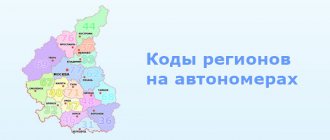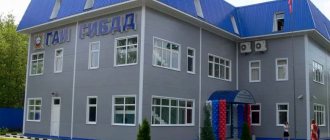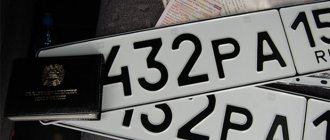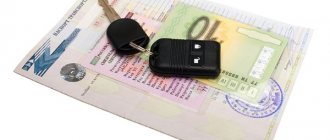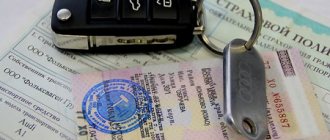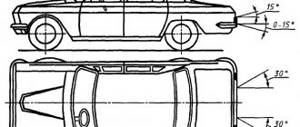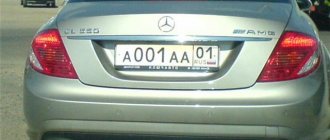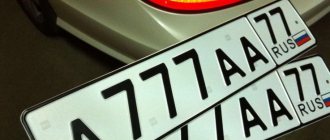Code table
Regions in the table are sorted by number and divided for convenience into blocks of ten records. In parentheses after the name of the region are the years in which license plates with the corresponding region code were issued. For such regions, new codes have been introduced, which are listed at the end of the list, indicating the year of entry into force. Regions without indications in brackets use only one code, which is still valid today. To quickly obtain all the codes for a particular region, we recommend using the search form or referring to the list of regions with several codes located below the table.
- 01—09
- 01 - Republic of Adygea
- 02 - Republic of Bashkortostan (1993–2006)
- 03 - Republic of Buryatia
- 04 - Altai Republic
- 05 - Republic of Dagestan
- 06 – Republic of Ingushetia
- 07 – Kabardino-Balkarian Republic
- 08 – Republic of Kalmykia
- 09 – Karachay-Cherkess Republic
- 10—19
- 10 - Republic of Karelia
- 11 - Komi Republic
- 12 - Republic of Mari El
- 13 – Republic of Mordovia
- 14 - Republic of Sakha (Yakutia)
- 15 - Republic of North Ossetia-Alania
- 16 - Republic of Tatarstan (1993–2006)
- 17 - Republic of Tyva
- 18 - Udmurt Republic
- 19 – Republic of Khakassia
- 20—29
- 20 - Chechen Republic (1993–2000)
- 21 – Chuvash Republic
- 22 - Altai Territory
- 23 - Krasnodar region (1993–2005)
- 24 - Krasnoyarsk Territory (1993–2009)
- 25 - Primorsky Krai (1993–2005)
- 26 - Stavropol Territory
- 27 — Khabarovsk region
- 28 - Amur region
- 29 — Arkhangelsk region
- 30—39
- 30 — Astrakhan region
- 31 - Belgorod region
- 32 - Bryansk region
- 33 - Vladimir region
- 34 - Volgograd region (1993–2012)
- 35 – Vologda region
- 36 - Voronezh region
- 37 - Ivanovo region
- 38 — Irkutsk region
- 39 — Kaliningrad region
- 40—49
- 40 - Kaluga region
- 41 - Kamchatka region
- 42 - Kemerovo region (1993–2011)
- 43 - Kirov region
- 44 - Kostroma region
- 45 – Kurgan region
- 46 - Kursk region
- 47 - Leningrad region
- 48 — Lipetsk region
- 49 – Magadan region
- 50—59
- 50 - Moscow region (1993–2001)
- 51 - Murmansk region
- 52 - Nizhny Novgorod region (1993–2009)
- 53 - Novgorod region
- 54 - Novosibirsk region (1993–2010)
- 55 — Omsk region
- 56 - Orenburg region
- 57 - Oryol region
- 58 - Penza region
- 59 - Perm region (1993–2010)
- 60—69
- 60 - Pskov region
- 61 - Rostov region (1993–2007)
- 62 - Ryazan region
- 63 - Samara region (1993–2007)
- 64 - Saratov region
- 65 - Sakhalin region
- 66 - Sverdlovsk region (1993–2006)
- 67 - Smolensk region
- 68 - Tambov region
- 69 - Tver region
- 70—79
- 70 - Tomsk region
- 71 - Tula region
- 72 - Tyumen region
- 73 - Ulyanovsk region
- 74 - Chelyabinsk region (1993–2007)
- 75 – Transbaikal region
- 76 - Yaroslavl region
- 77 – Moscow
- 78 - St. Petersburg (1993–2004)
- 79 – Jewish Autonomous Region
- 80—89
- 80 - Transbaikal region
- 81 - Perm region
- 82 - Republic of Crimea (since 2014)
- 83 – Nenets Autonomous Okrug
- 84 - Krasnoyarsk region
- 85 — Irkutsk region
- 86 - Khanty-Mansiysk Autonomous Okrug (1993–2012)
- 87 – Chukotka Autonomous Okrug
- 88 - Krasnoyarsk region
- 89 – Yamalo-Nenets Autonomous Okrug
- 90—99
- 90 - Moscow region (2001–2006)
- 91 - Kaliningrad region
- 92 - Sevastopol (since 2014)
- 93 - Krasnodar region (2005–2011)
- 94 - Territories located outside the Russian Federation and served by the Department of Security Facilities of the Ministry of Internal Affairs of Russia
- 95 - Chechen Republic (since 2000)
- 96 - Sverdlovsk region (2006–2013)
- 97 - Moscow (2002–2005)
- 98 - St. Petersburg (2004–2010)
- 99 - Moscow (1998–2002)
- 100—199
- 102 - Republic of Bashkortostan (since 2006)
- 113 – Republic of Mordovia
- 116 - Republic of Tatarstan (since 2006)
- 121 – Chuvash Republic
- 123 - Krasnodar region (since 2011)
- 124 - Krasnoyarsk Territory (since 2009)
- 125 - Primorsky Territory (since 2005)
- 126 - Stavropol Territory
- 134 - Volgograd region (since 2012)
- 136 - Voronezh region
- 138 — Irkutsk region
- 142 - Kemerovo region (since 2011)
- 150 - Moscow region (2006–2009)
- 152 - Nizhny Novgorod region (since 2009)
- 154 - Novosibirsk region (since 2010)
- 159 - Perm region (since 2010)
- 161 - Rostov region (since 2007)
- 163 - Samara region (since 2007)
- 164 - Saratov region
- 173 - Ulyanovsk region
- 174 - Chelyabinsk region (since 2007)
- 177 – Moscow
- 178 - St. Petersburg (since 2010)
- 186 - Khanty-Mansiysk Autonomous Okrug (since 2012)
- 190 - Moscow region (2009–2013)
- 196 - Sverdlovsk region (since 2013)
- 197 - Moscow (2010–2013)
- 199 - Moscow (2007–2010)
- 200—299
- 277 — Moscow
- 299 — Moscow
- 700—799
- 716 - Republic of Tatarstan (from 2021)
- 725 — Primorsky Krai
- 750 - Moscow region (since 2013)
- 763 - Samara region
- 777 - Moscow (2013–2017)
- 790 — Moscow region
- 799 - Moscow (from 2021)
Features of numbers from South Ossetia
South Ossetian license plates are made in the same format as Russian ones.
The main difference that catches your eye is the unusual flag. Instead of the usual colors, the number is red, yellow and white. For designations on the sign, Cyrillic letters are used, analogues of which are in the Latin alphabet. That is, it is prohibited to put Zh, Sh, Ts and other letters on the license plate that are not designated in Latin letters.
The letters RSO, which attract attention in the room along with the unusual flag, indicate the code of the republic and stand for Republic of South Ossetia.
Otherwise, there are no significant differences from Russian license plates. The license plate consists of:
- flag of South Ossetia;
- below it is the code of the republic;
- then the number itself, consisting of three letters and numbers.
Unlike Russian identifiers, the block containing the flag and code of the republic is located on the left side of the rectangle.
This format has been used since 2006.
Old and new codes
For 2021, 29 old codes are allocated, license plate numbers for which are not issued. Their list: 02, 16, 20, 23, 24, 25, 34, 42, 50, 52, 54, 59, 61, 63, 66, 74, 78, 86, 90, 93, 96, 97, 98, 99 , 150, 190, 197, 199, 777. 22 new codes are used instead of the old ones. List of new codes indicating the year of entry into force:
- 2000 - 95 (Chechen Republic)
- 2005 - 125 (Primorsky Territory)
- 2006 - 102 (Republic of Bashkortostan), 116 (Republic of Tatarstan)
- 2007 - 174 (Chelyabinsk region), 161 (Rostov region), 163 (Samara region)
- 2009 - 124 (Krasnoyarsk Territory), 152 (Nizhny Novgorod Region)
- 2010 - 178 (St. Petersburg), 154 (Novosibirsk region), 159 (Perm region)
- 2011 - 123 (Krasnodar region), 142 (Kemerovo region)
- 2012 - 134 (Volgograd region), 186 (Khanty-Mansi Autonomous Okrug)
- 2013 - 750 (Moscow region), 196 (Sverdlovsk region)
- 2014 - 92 (Sevastopol), 82 (Republic of Crimea)
- 2017 - 799 (Moscow), 716 (Republic of Tatarstan).
List of subjects of the Russian Federation with two or more codes:
- Volgograd region - 34, 134
- Kemerovo region - 42, 142
- Krasnodar region - 23, 93, 123
- Krasnoyarsk Territory - 24, 124
- Moscow - 97, 99, 197, 199, 777, 799
- Moscow region - 50, 90, 150, 190, 750
- Nizhny Novgorod region - 52, 152
- Novosibirsk region - 54, 154
- Perm region - 59, 159
- Primorsky Territory - 25, 125
- Republic of Bashkortostan - 02, 102
- Republic of Tatarstan - 16, 116, 716
- Rostov region - 61, 161
- Samara region - 63, 163
- St. Petersburg - 78, 98, 178
- Sverdlovsk region - 66, 96, 196
- Khanty-Mansiysk Autonomous Okrug - 86, 186
- Chelyabinsk region - 74, 174
- Chechen Republic - 20, 95
As of 2021, there are 19 such entities. Moscow and the Moscow region have the most codes, which is explained by the large number of cars owned by residents of the region.
Explanations and comments
According to the Order of the Ministry of Internal Affairs of January 5, 2000 No. 5, in 2000 all license plates of the Chechen Republic were replaced: instead of code 20, code 95 was used. License plates with code 20 can no longer be found on the roads. This measure is related to counteracting the situation of accumulation of criminal vehicles at that time.
According to the Order of the Ministry of Internal Affairs of June 26, 2013 No. 478, three-digit codes with the first digit 7 (777, 779, 799, etc.) were introduced in 2013. Instead of the expected 2, the number 7 is used, since a) 2 does not fit into the space allocated for the region code on the registration plate, b) 7 is better recognized by cameras recording offenses. However, a limited series of numbers with codes 277 and 299 were still issued.
The Perm region has three codes: 59, 81, 159. Code 81 is out of logic. This is due to the fact that on December 1, 2005, the Komi-Permyak Autonomous Okrug (code 81) and the Perm region (code 59) were united into the Perm Territory. Accordingly, code 81 passed to the Perm region.
According to the Order of the Ministry of Internal Affairs of August 7, 2013 No. 605, when reselling a car, it is allowed to keep the old license plates. Replacement with new numbers can be carried out at the request of the new owner. Thus, linking the code on the license plate to the region of residence/registration of the owner ceases to be relevant.
Other types of license plates
- License plates for trailers and semi-trailers.
In the 1993 standard, they differ from car license plates by the presence of only two letters at the beginning of the number (there is a distance between the letters); there is both a single-row and a double-row design. In the 2014 standard, they differ from automobile ones by the presence of only one letter in the second group of letters in both single-row and double-row versions. - Motorcycle license plates.
The signs are double-row, two letters are placed in the top row, four numbers are placed in the bottom row, the flag of Georgia and the vehicle code are placed on the left. In the 2014 standard, only the font and type of national symbols have changed. - License plates of agricultural, road and special equipment and trailers for them.
They differ from motorcycle signs by the presence of only three numbers in the bottom row, which makes them almost identical to a two-row trailer sign. The only difference is that the state flag of Georgia is placed on the license plates of the special equipment. - Transit license plates (export).
They are executed in black symbols on a white background, with four numbers placed on the left and two letters on the right. Between the letters and numbers there is a red stripe with rectangular white windows located one below the other; the year of validity of the number is written in the upper window, and the month in the lower one (in fact, the lower window most often remains empty). - Transit license plates (domestic).
differ
from automobile ones by the presence of two letters and four numbers, there is no space between the letters, the first letter is most often
T. There are also motorcycle transit plates, they have one letter (most often T
) in the top row and three numbers in the bottom. In the 2014 standard, the font, the color of the symbols from black to red and the type of national symbols changed, and the number of digits for motorcycles also increased from three to four. - Non-resident license plates.
They are executed in black characters on a yellow background, the format is the letter combination
FG
and five numbers. Since approximately the mid-2000s, these numbers have not been issued. - Diplomatic license plates.
They are executed with white symbols on a red background, the format is three numbers, a status letter, from one to three numbers. One digit is placed on the cars of heads of diplomatic missions, two (much less often - three) digits are placed on all other license plates. The status letter indicates:
D
- an employee with diplomatic status,
T
- employee without diplomatic status (technical personnel),
CMD
- car of the head of the diplomatic mission.
In the 2014 standard, the font changed, the number of digits after the status always became three, and the letters SS
- consular officers.
- A type of diplomatic number are the numbers of foreign companies
AS
is placed in place of the status letter . In the 2014 standard, only the font has changed.
- License plates of the EU Monitoring Mission.
They are executed in white characters on a blue background, the format is the letter combination
EUMM
and three numbers. - Military license plates.
They are executed in white characters on a black background, the format is two letters and three numbers.
On the left of the license plate there is a narrow green strip on which the letters G
and
A
.
New format
From January 1, 2021, in accordance with Rosstandart Order N 555-ct, a new national standard of the Russian Federation GOST R 50577-2018 “State registration signs of vehicles” is approved. Types and main sizes. Technical requirements" instead of the old GOST R 50577-93. New 10 types of license plates are being introduced for vehicles, depending on the type and category of the vehicle: motorcycles, ATVs, cars with mounts for “square” license plates, sports cars, and vintage cars.
The Government is discussing the issue of changing the format of car license plates. It is planned to abandon region numbers and increase the combination of numbers and letters. Linking to a region number has now lost its relevance, since the region of registration of the vehicle owner and the region of registration of the vehicle may not coincide - motorists are allowed to keep old numbers when buying a used car. Increasing the combination of letters and numbers will avoid a shortage of options for regions with a large number of cars and will make the numbers closer to the European format. In addition, the possibility of installing electronic chips in license plates for remote reading of vehicle registration data is being discussed.
An idea from the NTI Autonet working group to introduce green license plates for electric vehicles in Russia is also being considered.
Information about automobile region codes is generated based on published data from the State Traffic Safety Inspectorate. Data update date: 01/08/2019.
© 2014-2019 Business directory "codifier.ru"
Good afternoon, dear reader.
In this article we will talk about state registration plates (car license plates) . Number plates for a car are issued immediately after its registration with the traffic police and remain in place until one of the next owners decides to replace them.
Registration marks are unique, i.e. Two different cars cannot have the same number plates at the same time. The numbers always differ by at least one letter or number. Today we will look at the features and procedure for issuing license plates, as well as automobile region codes on the license plates.
How to find out the license plate number of a car
The state number of a vehicle (state number) is a combination of numbers and letters printed on a special plastic or metal plate on the front and rear sides of the vehicle. Any vehicle must have a state number. The main purpose of the state number is to record vehicles.
Since 1993, the production of state license plates for vehicles in the Russian Federation has been carried out according to a single model. Such numbers contain three letters and three numbers. The first letter indicates the serial number of the vehicle. Three digits indicate the registration number of the vehicle, which is assigned by the traffic police. The next three letters also indicate the serial number of the vehicle.
On the right side, all state license plates of vehicles have additional marks, which indicate that the vehicle is registered on the territory of the Russian Federation. These include the image of the state emblem, flag, abbreviation of the Russian Federation, as well as the code of the region in which the vehicle is registered.
The license plate number of the car can be seen in the photographs in the advertisement for the sale of the car. If the car number is hidden in the photo, call the seller. Usually, conscientious sellers do not hide the car number. If the seller is unwilling to share the license plate number until you come in for an inspection, you are most likely talking to a representative from a gray dealership.
The procedure for issuing license plates in Russia
Let's consider the most common type of numbers in the Russian Federation:
These are the numbers that are installed on most cars.
At first glance, the number consists of a random sequence of letters and numbers. In fact, not everything is so simple here.
All numbers from 0 to 9 are used on license plates. However, unlike numbers, not all letters of the Russian alphabet can appear on license plates. This privilege is given only to those letters that have similar spellings in the Latin alphabet. Those. Only the letters A, B, E, K, M, N, O, R, S, T, U, X can be used on license plates.
Car plate numbers
The 1993 standard Georgian license plate is a white rectangular plate with black symbols on it. On the left side of the number is the flag of Georgia and below it the country code “ GE”
" or "
GEO
". The license plate itself consists of 3 letters of the Latin alphabet and 3 numbers separated by a hyphen. In a two-row version of the license plate, the letters are placed in the top row, the numbers are in the bottom, there is no hyphen, and the state flag is also not drawn.
Initially, each region issued license plates starting with a certain letter, for example, the Tbilisi traffic police issued license plates starting with the letter A
, Adjara traffic police - with the letter
B
, Abkhazia traffic police - with the letter
C
, Zugdidi traffic police - with the letter
F
, but then it became possible to take any number, including by individual order (any combination of no more than six characters), in any place, officially paying a certain amount to the budget.
The 2014 standard car number differs from the previous one: on the left side there is national symbols (country flag and GE
), stylized as European numbers; the number itself is written in FE font and consists of two Latin letters, three numbers and two more Latin letters; groups of letters and numbers are separated by hyphens. In a two-row license plate, the first two letters are placed in the top row, and the numbers and remaining letters are in the bottom row. License plates have no regional reference.
Abkhazia and South Ossetia (partially recognized states that the Georgian side considers an integral part of Georgia) issue their own license plates.
Georgian license plate encoding standard 1993
1) AAA - AAZ belongs to Tbilisi.
2) EEK, EES, EEY, EAD, EAK, EAQ, VYV, VCV, VIV, IID belongs to Marneuli and Marneuli municipality.
3) EEF, EEP and EEQ belong to Bolnisi and Bolnisi municipality.
4) KZZ, KZY belongs to Tkibuli and Tkibul municipality.
5) DDD - belongs to Kutaisi
Automotive region code table for 2019 and 2021
| Code | The subject of the Russian Federation |
| 01 | Republic of Adygea |
| 02, 102 | Republic of Bashkortostan |
| 03 | The Republic of Buryatia |
| 04 | Altai Republic (Altai Mountains) |
| 05 | The Republic of Dagestan |
| 06 | The Republic of Ingushetia |
| 07 | Kabardino-Balkarian Republic |
| 08 | Republic of Kalmykia |
| 09 | Republic of Karachay-Cherkessia |
| 10 | Republic of Karelia |
| 11 | Komi Republic |
| 12 | Mari El Republic |
| 13, 113 | The Republic of Mordovia |
| 14 | The Republic of Sakha (Yakutia) |
| 15 | Republic of North Ossetia-Alania |
| 16, 116, 716 | Republic of Tatarstan |
| 17 | Tyva Republic |
| 18 | Udmurt republic |
| 19 | The Republic of Khakassia |
| 21, 121 | Chuvash Republic |
| 22 | Altai region |
| 23, 93, 123 | Krasnodar region |
| 24, 84, 88, 124 | Krasnoyarsk region |
| 25, 125 | Primorsky Krai |
| 26, 126 | Stavropol region |
| 27 | Khabarovsk region |
| 28 | Amur region |
| 29 | Arhangelsk region |
| 30 | Astrakhan region |
| 31 | Belgorod region |
| 32 | Bryansk region |
| 33 | Vladimir region |
| 34, 134 | Volgograd region |
| 35 | Vologda Region |
| 36, 136 | Voronezh region |
| 37 | Ivanovo region |
| 38, 85, 138 | Irkutsk region |
| 39, 91 | Kaliningrad region |
| 40 | Kaluga region |
| 41 | Kamchatka Krai |
| 42, 142 | Kemerovo region |
| 43 | Kirov region |
| 44 | Kostroma region |
| 45 | Kurgan region |
| 46 | Kursk region |
| 47, 147 | Leningrad region |
| 48 | Lipetsk region |
| 49 | Magadan Region |
| 50, 90, 150, 190, 750 | Moscow region |
| 51 | Murmansk region |
| 52, 152 | Nizhny Novgorod Region |
| 53 | Novgorod region |
| 54, 154 | Novosibirsk region |
| 55 | Omsk region |
| 56, 156 | Orenburg region |
| 57 | Oryol Region |
| 58 | Penza region |
| 59, 81, 159 | Perm region |
| 60 | Pskov region |
| 61, 161, 761 | Rostov region |
| 62 | Ryazan Oblast |
| 63, 163, 763 | Samara Region |
| 64, 164 | Saratov region |
| 65 | Sakhalin region |
| 66, 96, 196 | Sverdlovsk region |
| 67 | Smolensk region |
| 68 | Tambov Region |
| 69 | Tver region |
| 70 | Tomsk region |
| 71 | Tula region |
| 72 | Tyumen region |
| 73, 173 | Ulyanovsk region |
| 74, 174 | Chelyabinsk region |
| 75, 80 | Transbaikal region |
| 76 | Yaroslavl region |
| 77, 97, 99, 177, 197, 199, 777, 799 | Moscow |
| 78, 98, 178, 198 | Saint Petersburg |
| 79 | Jewish Autonomous Region |
| 82 | Republic of Crimea |
| 83 | Nenets Autonomous Okrug |
| 86, 186 | Khanty-Mansiysk Autonomous Okrug - Ugra |
| 87 | Chukotka Autonomous Okrug |
| 89 | Yamalo-Nenets Autonomous Okrug |
| 92 | Sevastopol |
| 94 | Territories located outside the Russian Federation and served by the Department of Security Facilities of the Ministry of Internal Affairs of Russia |
| 95 | Chechen Republic |
Three-digit area codes starting with the number 2
In feature films and television programs, you can see three-digit area codes starting with the number 2 or 3. For example, drivers often wonder what city regions 200, 202, 203, 211, 225, 236, 277 or 303 belong to.
To understand what region 202 on a car number means, let’s turn to Appendix 1 to the order “On state registration plates of vehicles”:
Note. On registration plates of vehicles classified as type 1, it is allowed to use the number “1” or “7” as the first digit of the code in the three-digit region code.
Thus, three-digit area codes can only begin with the number 1 or 7. Other digits are not used in area codes because They don't fit the width of the number.
So, if you come across numbers with an area code of 200, 202, 203, 211, 225, 236, 265 or 277, then keep in mind that their installation is illegal , and the numbers themselves are fake. In this case, first of all, call the traffic police by phone 102 and report a car with fake license plates.
The same applies to codes ending with two zeros, because region number 00 does not exist .
By the way, if you have seen cars with region numbers that are not in the table given here, write about it in the comments.
Traveling to Russia
Cars with Abkhaz license plates are allowed to drive on Russian roads. In this case, it is necessary to submit the following documents to the traffic police officers upon request:
- Driver license ;
- Technical passport;
- Rental agreement and waybill if the car is rented. They may also require statutory documentation for the organization to which the car is attached and a travel certificate;
- Customs declaration;
- OSAGO.
It should be borne in mind that usually Russian “road guards” do not require statutory documentation for an LLC; this is necessary for driving around Abkhazia, but it is better to have these papers with you.
All regions of license plates are presented here in digital order
Most Popular:
- Moscow - 77, 97, 99, 177, 197, 199, 277, 299, 777, 799.
- Moscow region - 50, 90, 150, 190, 750, 790.
- St. Petersburg - 78, 98, 178.
- Republic of Crimea - 82.
- Sevastopol - 92.
- 100, 200, 201, 202, 203, 211, 225, 236, 265 and 729 are fake numbers. Such numbers do not exist!
All area codes
- 01—09
- 01 - Republic of Adygea
- 02 - Republic of Bashkortostan (1993–2006)
- 03 - Republic of Buryatia
- 04 - Altai Republic
- 05 - Republic of Dagestan
- 06 – Republic of Ingushetia
- 07 – Kabardino-Balkarian Republic
- 08 – Republic of Kalmykia
- 09 – Karachay-Cherkess Republic
- 10—19
- 10 - Republic of Karelia
- 11 - Komi Republic
- 12 - Republic of Mari El
- 13 – Republic of Mordovia
- 14 - Republic of Sakha (Yakutia)
- 15 - Republic of North Ossetia-Alania
- 16 - Republic of Tatarstan (1993–2006)
- 17 - Republic of Tyva
- 18 - Udmurt Republic
- 19 – Republic of Khakassia
- 20—29
- 20 - Chechen Republic (1993–2000)
- 21 – Chuvash Republic
- 22 - Altai Territory
- 23 - Krasnodar region (1993–2005)
- 24 - Krasnoyarsk Territory (1993–2009)
- 25 - Primorsky Krai (1993–2005)
- 26 - Stavropol Territory
- 27 — Khabarovsk region
- 28 - Amur region
- 29 — Arkhangelsk region
- 30—39
- 30 — Astrakhan region
- 31 - Belgorod region
- 32 - Bryansk region
- 33 - Vladimir region
- 34 - Volgograd region (1993–2012)
- 35 – Vologda region
- 36 - Voronezh region
- 37 - Ivanovo region
- 38 — Irkutsk region
- 39 — Kaliningrad region
- 40—49
- 40 - Kaluga region
- 41 - Kamchatka region
- 42 - Kemerovo region (1993–2011)
- 43 - Kirov region
- 44 - Kostroma region
- 45 – Kurgan region
- 46 - Kursk region
- 47 - Leningrad region
- 48 — Lipetsk region
- 49 – Magadan region
- 50—59
- 50 - Moscow region (1993–2001)
- 51 - Murmansk region
- 52 - Nizhny Novgorod region (1993–2009)
- 53 - Novgorod region
- 54 - Novosibirsk region (1993–2010)
- 55 — Omsk region
- 56 - Orenburg region
- 57 - Oryol region
- 58 - Penza region
- 59 - Perm region (1993–2010)
- 60—69
- 60 - Pskov region
- 61 - Rostov region (1993–2007)
- 62 - Ryazan region
- 63 - Samara region (1993–2007)
- 64 - Saratov region
- 65 - Sakhalin region
- 66 - Sverdlovsk region (1993–2006)
- 67 - Smolensk region
- 68 - Tambov region
- 69 - Tver region
- 70—79
- 70 - Tomsk region
- 71 - Tula region
- 72 - Tyumen region
- 73 - Ulyanovsk region
- 74 - Chelyabinsk region (1993–2007)
- 75 – Transbaikal region
- 76 - Yaroslavl region
- 77 – Moscow
- 78 - St. Petersburg (1993–2004)
- 79 – Jewish Autonomous Region
- 80—89
- 80 - Transbaikal region
- 81 - Perm region
- 82 - Republic of Crimea (since 2014)
- 83 – Nenets Autonomous Okrug
- 84 - Krasnoyarsk region
- 85 — Irkutsk region
- 86 - Khanty-Mansiysk Autonomous Okrug (1993–2012)
- 87 – Chukotka Autonomous Okrug
- 88 - Krasnoyarsk region
- 89 – Yamalo-Nenets Autonomous Okrug
- 90—99
- 90 - Moscow region (2001–2006)
- 91 - Kaliningrad region
- 92 - Sevastopol (since 2014)
- 93 - Krasnodar region (2005–2011)
- 94 - Territories located outside the Russian Federation and served by the Department of Security Facilities of the Ministry of Internal Affairs of Russia
- 95 - Chechen Republic (since 2000)
- 96 - Sverdlovsk region (2006–2013)
- 97 - Moscow (2002–2005)
- 98 - St. Petersburg (2004–2010)
- 99 - Moscow (1998–2002)
- 100—199
- 102 - Republic of Bashkortostan (since 2006)
- 113 – Republic of Mordovia
- 116 - Republic of Tatarstan (since 2006)
- 121 – Chuvash Republic
- 123 - Krasnodar region (since 2011)
- 124 - Krasnoyarsk Territory (since 2009)
- 125 - Primorsky Territory (since 2005)
- 126 - Stavropol Territory
- 134 - Volgograd region (since 2012)
- 136 - Voronezh region
- 138 — Irkutsk region
- 142 - Kemerovo region (since 2011)
- 150 - Moscow region (2006–2009)
- 152 - Nizhny Novgorod region (since 2009)
- 154 - Novosibirsk region (since 2010)
- 159 - Perm region (since 2010)
- 161 - Rostov region (since 2007)
- 163 - Samara region (since 2007)
- 164 - Saratov region
- 173 - Ulyanovsk region
- 174 - Chelyabinsk region (since 2007)
- 177 – Moscow
- 178 - St. Petersburg (since 2010)
- 186 - Khanty-Mansiysk Autonomous Okrug (since 2012)
- 190 - Moscow region (2009–2013)
- 196 - Sverdlovsk region (since 2013)
- 197 - Moscow (2010–2013)
- 199 - Moscow (2007–2010)
- 700—799
- 716 - Republic of Tatarstan (from 2021)
- 725 — Primorsky Krai
- 750 - Moscow region (since 2013)
- 763 - Samara region
- 777 - Moscow (2013–2017)
- 790 — Moscow region
- 799 - Moscow (from 2021)
